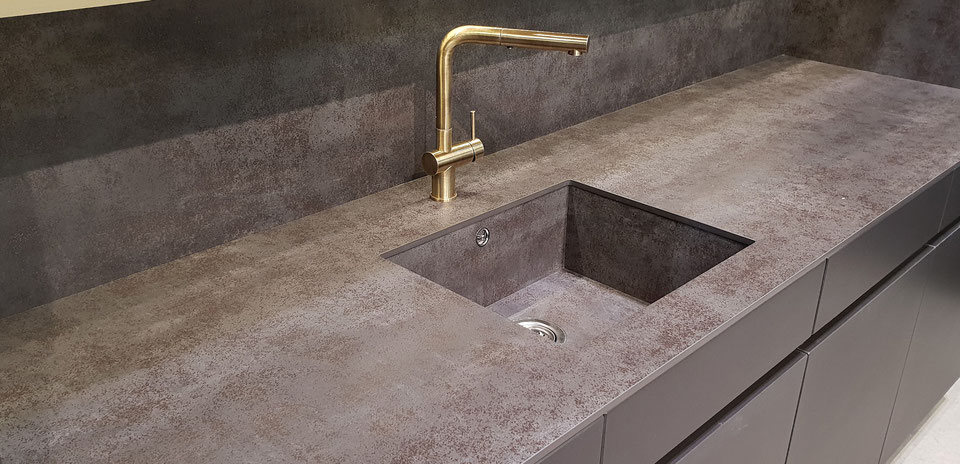Sintered stone is a buzzword that’s making the rounds in the world of interior design and architecture. But what is sintered stone? This innovative material is making waves for its durability, versatility and eco-friendly properties. If you’ve been considering a kitchen or bathroom makeover, read on to understand why sintered stone might be the perfect fit for your project.
We can safely say a sintered stone countertop might be the best thing to add to your kitchen.
Sintered Stone: A Snapshot
Sintered stone material is a man-made product that replicates the beauty and strength of natural stone. Its manufacturing process mimics the way natural raw materials like granite and marble are formed over thousands of years, but achieved much quicker. Brands such as Neolith, Dekton, and Lapitec are the leading manufacturers of this impressive material.
The Genesis of Sintered Stone
Sintered stone is created using natural minerals and stone particles. These are subjected to extreme heat and pressure, similar to the natural formation process of stones in the Earth’s crust, but at a much faster rate. The resulting product is a material that is incredibly robust, resistant to heat and stains, and boasts a myriad of applications.
The Sintering Process Explained
The term ‘sintering’ refers to the process of forming a solid mass of material by heat or pressure without melting it to the point of liquefaction. In the case of sintered stone, this involves applying immense pressure of up to 400 bars (5800 PSI!) and baking the materials at a temperature of 1200ºC. The result is a slab of stone that is incredibly strong, versatile and durable.
The Unique Properties of Sintered Stone
One of the reasons sintered stone has become a popular choice for homeowners and designers alike is its unique properties. It combines the strength and heat resistance of granite with the stain resistance of quartz, without the drawbacks associated with each. Here’s a snapshot of sintered stone’s main properties:
- Heat Resistance: Unlike quartz, sintered stone is resistant to high temperatures, meaning it won’t scorch or discolor when exposed to heat
- Stain Resistance: Much like quartz, sintered stone is non-porous and highly resistant to stains
- UV Resistance: Sintered stone is not affected by UV light, making it suitable for outdoor applications
- Scratch Resistance: Sintered stone is incredibly hard and resistant to scratches and chips
- Low Maintenance: Sintered stone does not require sealing and is easy to clean
Applications of Sintered Stone
One of the key advantages of sintered stone is its versatility. It can be used for a wide range of applications, both indoors and outdoors, thanks to its impressive properties. Here are some of the potential uses of sintered stone:
- Worktops: Its resistance to heat and stains makes it a perfect material for a kitchen worktop.
- Vanity Tops: Sintered stone is ideal for bathroom vanity tops thanks to its non-porous nature and ease of maintenance.
- Flooring: Its durability and resistance to wear and tear make it a great choice for flooring.
- Wall Cladding: Sintered stone can be used for wall cladding, both indoors and outdoors.
- Furniture: With its wide range of colors and styles, sintered stone can be used to create unique and stylish pieces of furniture.
The Environmental Impact of Sintered Stone
In today’s environmentally-conscious world, the sustainability of materials is a key consideration for many homeowners. Sintered stone scores highly on this front. It’s made entirely from natural materials, meaning it has a lower environmental impact compared to quartz, which contains resin. Some manufacturers, like Neolith, even include recycled materials in their slabs, further reducing their environmental footprint.
The Cost of Sintered Stone
Given its many benefits, you might be wondering about the cost of sintered stone. While it’s not the cheapest option on the market, it’s not the most expensive either. The cost will depend on the complexity of your project, the thickness of the slabs you choose, and the specific brand of sintered stone you opt for. However, most sintered stone products start at a similar price to a mid-priced quartz, making it a viable option for a wide range of budgets.
Installation Considerations
While sintered stone is a fantastic material, it’s not recommended for DIY installations. This is because it can be complex to fabricate and requires special tools and machinery. It’s also heavy, so it needs to be correctly supported to prevent cracking or damage. Therefore, it’s best to enlist the help of professionals when installing sintered stone in your home.
Sintered Stone vs. Other Materials
When it comes to countertops and other home surfaces, sintered stone surface stands up well against other popular materials like quartz and granite. While quartz and granite each have their strengths, sintered stone combines the best of both worlds – the heat resistance of granite and the stain resistance of quartz, without the need for sealing or special maintenance.
In Conclusion
So, what is sintered stone? It’s a versatile, durable, and beautiful material that can elevate the look and functionality of your home. Whether you’re embarking on a kitchen remodel, designing a new bathroom, or planning an outdoor project, sintered stone is a material worth considering. If you want a sintered surface, there are plenty of benefits to using this material.






